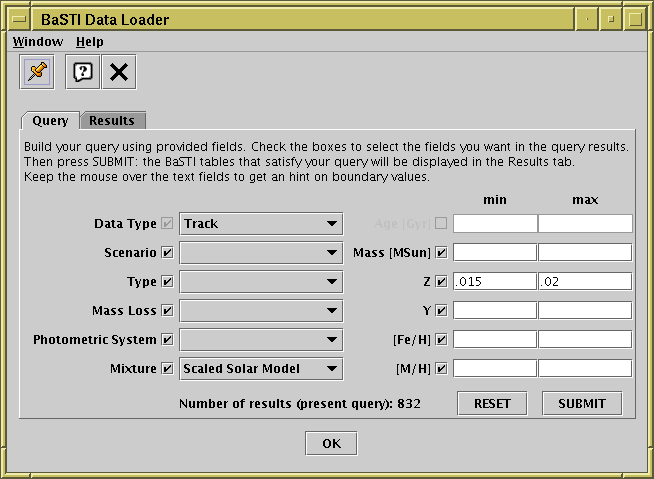
BaSTI load dialog query tab

BaSTI load dialog query tab
This dialogue,selected from the
Load Window's toolbar button (![]() )
or the main VO menu,
allows direct queries to the BaSTI
(Bag of Stellar Tracks and Isochrones) database
hosted by the INAF-Teramo Astronomical Observatory.
You can find
more detailed documentation
on the web site.
)
or the main VO menu,
allows direct queries to the BaSTI
(Bag of Stellar Tracks and Isochrones) database
hosted by the INAF-Teramo Astronomical Observatory.
You can find
more detailed documentation
on the web site.
This load dialogue has two tabs: a Query tab to input search parameters, and a Results tab to display the results table with one row for each table resulting from the user's query.
The Query tab contains a set of parameters by which the query will be constrained, some aids to help the user while preparing the selection and two buttons. The Reset button simply clears query inputs and (if present) user's selections in the Results tab. The Submit button performs the query and switches the dialog to the Results tab. As an aid to allow a refined query without too much recursive steps, at the bottom center of the tab, a counter displays how many rows (i.e. resulting tables) the output will count. Remembering that the results will contain 30 rows at maximum, the user can than refine his/her constrains to reduce the number of results.
To do so the query helps the user in two ways mainly: automatically unselecting the unavailable parameters for a specific query (e.g. the mass range for an isochrone search) and displaying, for the ranged parameters, the value limits for that parameter, this happens just moving the mouse cursor over the input area.
Here follows a short description of the query parameters, for full details refer to the BaSTI main site.
Once the Query panel has been filled in, hit the Submit button. This will show the Results tab. This displays a table where each row refers to an available result from the BaSTI database as constrained by the user's query. On top of the table the number of results identified by the query is recalled. The user now can switch back to refine the query or selected (mouse clicking) the table/s he/she wants to load into TOPCAT. Once the selection is ready (CTRL+click or SHIFT+click for multiple selections) pressing the OK button will load the tables into TOPCAT.